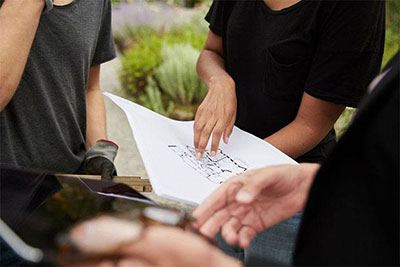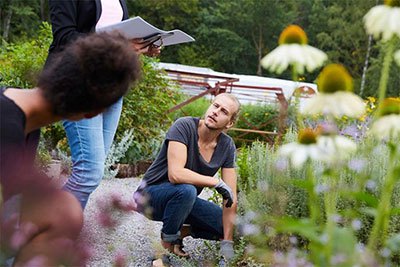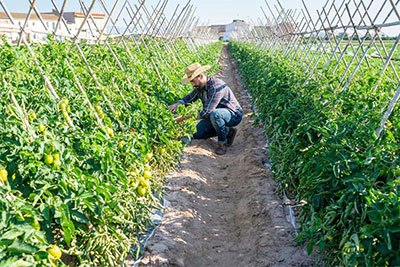Most homeowners decorate their homes with a variety of potted plants. Plants bring life to your home’s interior. In some cases, you may eventually decide to move it to your outdoor space and cultivate it into a garden flower bed.
So, is it possible to replant your potted greens in the ground without damaging the plant? The answer is yes.
When transplanting a plant from a pot to the ground, you should follow the steps below to ensure a successful procedure.
Moving a healthy plant doesn’t just require digging and transferring the roots. You should take more precautions when doing this gardening project. In this article, we’ll show you how it is done properly.
Table of Contents
Here are the materials that you’ll need

– Potted plant
– Organic matter (compost, peat moss, decomposed manure, leaf mold)
– Water
– Hose or bucket
– Shovel
– Trowel
– Knife
Step-by-step
Whether your old plant is already too big for its pot or you simply feel like it’s time to move your plant into the garden, transferring it isn’t as simple as you may think.
It requires proper care and handling. You don’t just pull it out and dump it on the ground and expect it to grow.
A successful transplant requires proper planning and following certain procedures. You don’t have to worry, though, because you don’t have to be a professional gardener to be able to do this.
Just follow these steps.
1. Check the compatibility

Before you start, keep your potted plant watered regularly to prepare it for transfer. Check if your plant can actually survive once you transfer it to the ground.
Do your research and study the plant’s structure and identify what type of temperature, sunlight, soil, and water conditions it can thrive in. You can also try to let your potted plant sit in the sunlight for a few days before you move it. This will test the adaptability of the plant.
We recommend you conduct your transplant late in the afternoon or during the evening. If you must do it in the morning, schedule it before sunrise to avoid the heat of the sun.
A cloudy day is even better.
2. Prepare the ground
Dig a hole that is 3 to 4 times wider than your potted plant and at least 1 ½ times deeper than its height. The hole should be wide and deep enough to accommodate the plant’s roots.
Make sure that the ground is either moist or dry and not muddy. Then add the organic matter to the extracted soil.
Put in the compost, peat moss, decomposed manure, and leaf mold into the soil and mix some soil back into the hole. Then fill the hole with water.
3. Remove the plant from the pot

Carefully loosen the soil in the pot and place your hand on the base of the plant over the soil. Use your other hand to tip the pot over.
The plant and soil should come out of the pot in one piece. If this doesn’t work smoothly the first time, check if the roots have extended to the bottom of the pot and cut it. Be careful when handling the roots, and do not just pull the plant from the pot because it may damage the roots.
Avoid exposing the roots to sun, wind, or heat because it can add more damage to the plant. In some pots, the roots tend to form a thick layer on the outer part of the root ball. In this case, you should cut the roots on the bottom and sides using a knife.
Cutting the roots may stimulate the growth of the roots. If the roots appear too constricted, try to loosen them using your fingers. When removing the plant, handle it with care to avoid damaging the stems and leaves.
4. Place the plant in the hole
Make sure you have your base ready when you put your plant in it. Then fill in the gaps with loose dirt until the hole is entirely filled.
Make sure you seal all gaps because the soil should be able to support the plant and roots in place. Fill half of the hole with water. This ensures that there are no air pockets left in the ground.
5. Water the plant

Once you’re done, water your plant until it adapts to its new environment. Then continue to follow the instructions on how to maintain and take care of the plant properly.
We recommend setting up a temporary shade for your plant to avoid wilting from the sun. More importantly, make sure that your plant is getting the right amount of water it requires. You may water it daily or even twice a day if the weather is extremely hot.
After completing the transplant, use your empty pot and recycle it by planting a new plant. You can plant your favorite flower or herb. If you don’t have plans of using it for planting, you can use it for other purposes.
Get creative. You can transform it into a container for your kitchen tools or ingredients. You can even transform it into a home décor. Just make sure you clean it well and give it a fresh can of paint to make it look more attractive.
Final thoughts
Now that you have an idea of how to transfer your potted plant into the ground successfully, I suggest you take on the challenge and do this task in your garden or backyard.
You can ask your kids to help you water the plants so that they are aware of how important it is to take care of the plant properly. This is a great gardening project that you can get everyone to participate in.
You don’t even have to call a professional gardener to do this task for you. Just follow the steps above, and you’ll be able to transplant on your own successfully.
If you find this article helpful and informative, please share it with your friends. We are open to your comments, suggestions, and questions.
